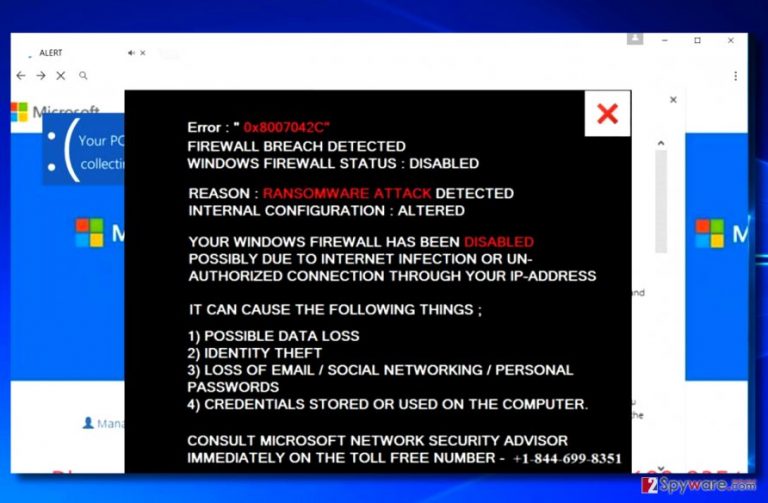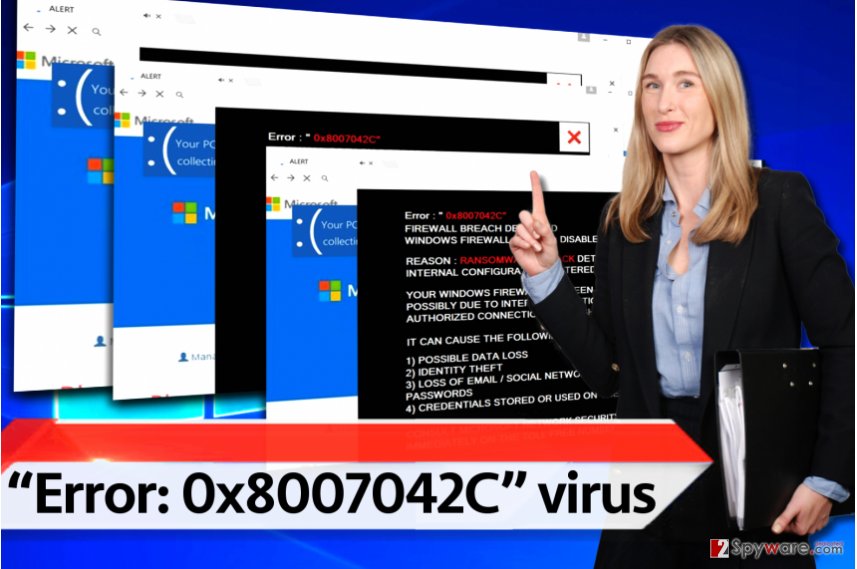“Error: 0x8007042C” virus (Microsoft Support Scam) - Virus Removal Guide
“Error: 0x8007042C” virus Removal Guide
What is “Error: 0x8007042C” virus?
Error: 0x8007042C pop-ups: more scareware rather than actual alert

Error: 0x8007042C virus functions as a scam warning designed by tech support scammers. You may encounter this false alarm after visiting a fraudulent website. Downloading a corrupted program may also evoke such notification[1].
Typically, such fake alert seeks to frighten a user by stating that Firewall breach was detected and that some kind of ransomware is trying to infect the system. After noticing such alerts, the user should perform Error: 0x8007042C removal immediately.
The authors of such deceptive projects seek to convey the sense or urgency and convince the victim call tech support scammers that claim to be working at Microsoft[2]. The malware typically makes the computer lag and keeps opening deceptive pop-ups that falsely inform the victim that the imaginary malware was detected on the system that can result in such problems:
- Possible data loss;
- Identity theft;
- Loss of email/social networking/personal passwords;
- Credentials stored or used on the computer.
Error: 0x8007042C popup typically suggests calling +1-844-699-8351. Do not dial any number provided by shady pop-up alerts or websites that urge you to contact Microsoft “certified technicians”. If you do, crooks might use deceptive techniques and social engineering to swindle money from you by false pretenses. Fraudsters tend to indicate problems and errors that signal a destructive infection present on a PC, but, in reality, these messages are no more than fake alerts. They felons urge to do one of the following:
- Provide remote access to attackers via legitimate remote control programs such as TeamViewer or LogMeIn;
- Buy security software packs that are highly overpriced;
- Provide sensitive data such as full name, email, or credit card details.

It is unwise to comply with the demands of shady technicians who pretend to be able to fix your computer issue via phone or remote control programs. If you call them, most likely they will suggest you to open specific system folders, enter some commands into Run prompt or CMD. So if your browser started displaying 0x8007042C alerts, remove Error: 0x8007042C as soon as you can. We suggest you check the system with a program like FortectIntego and let it eliminate detected malware automatically.
Distribution of tech support scams
Tech support scam developers tend to infect computers by deception. They force users to silently install their malware by bundling it alongside popular free programs. However, the attackers might also distribute this virus via spam or illegal software packs. Be careful and choose files to download responsibly.
We highly suggest reading user reviews online and checking the reliability of the website that provides software download link. What is also important is that you install the downloaded software using the right settings. You should never go for Standard/Default settings and choose Custom/Advanced ones instead so that you could decompose the software pack by deselecting unwanted additions.
Note that such fake message may be tied to a specific website. Usually, it happens to be a gaming or movie streaming website. In order to avoid such encounter in the future, make sure your anti-security is updated.
Get rid of Error: 0x8007042C pop-ups
If the described error message keeps bothering you on a daily basis and the computer runs slower than ever, remove Error: 0x8007042C virus immediately. It is very hard to identify the program that sends these alerts to you; in some cases, the virus does not even leave a standalone program on the system but modifies Windows Registry values instead. To perform a professional Error: 0x8007042C removal, we suggest using anti-spyware programs.
Getting rid of “Error: 0x8007042C” virus. Follow these steps
Manual removal using Safe Mode
Before running your anti-spyware or anti-malware software, reboot your PC using these instructions.
Important! →
Manual removal guide might be too complicated for regular computer users. It requires advanced IT knowledge to be performed correctly (if vital system files are removed or damaged, it might result in full Windows compromise), and it also might take hours to complete. Therefore, we highly advise using the automatic method provided above instead.
Step 1. Access Safe Mode with Networking
Manual malware removal should be best performed in the Safe Mode environment.
Windows 7 / Vista / XP
- Click Start > Shutdown > Restart > OK.
- When your computer becomes active, start pressing F8 button (if that does not work, try F2, F12, Del, etc. – it all depends on your motherboard model) multiple times until you see the Advanced Boot Options window.
- Select Safe Mode with Networking from the list.

Windows 10 / Windows 8
- Right-click on Start button and select Settings.

- Scroll down to pick Update & Security.

- On the left side of the window, pick Recovery.
- Now scroll down to find Advanced Startup section.
- Click Restart now.

- Select Troubleshoot.

- Go to Advanced options.

- Select Startup Settings.

- Press Restart.
- Now press 5 or click 5) Enable Safe Mode with Networking.

Step 2. Shut down suspicious processes
Windows Task Manager is a useful tool that shows all the processes running in the background. If malware is running a process, you need to shut it down:
- Press Ctrl + Shift + Esc on your keyboard to open Windows Task Manager.
- Click on More details.

- Scroll down to Background processes section, and look for anything suspicious.
- Right-click and select Open file location.

- Go back to the process, right-click and pick End Task.

- Delete the contents of the malicious folder.
Step 3. Check program Startup
- Press Ctrl + Shift + Esc on your keyboard to open Windows Task Manager.
- Go to Startup tab.
- Right-click on the suspicious program and pick Disable.

Step 4. Delete virus files
Malware-related files can be found in various places within your computer. Here are instructions that could help you find them:
- Type in Disk Cleanup in Windows search and press Enter.

- Select the drive you want to clean (C: is your main drive by default and is likely to be the one that has malicious files in).
- Scroll through the Files to delete list and select the following:
Temporary Internet Files
Downloads
Recycle Bin
Temporary files - Pick Clean up system files.

- You can also look for other malicious files hidden in the following folders (type these entries in Windows Search and press Enter):
%AppData%
%LocalAppData%
%ProgramData%
%WinDir%
After you are finished, reboot the PC in normal mode.
Finally, you should always think about the protection of crypto-ransomwares. In order to protect your computer from “Error: 0x8007042C” and other ransomwares, use a reputable anti-spyware, such as FortectIntego, SpyHunter 5Combo Cleaner or Malwarebytes
How to prevent from getting malware
Choose a proper web browser and improve your safety with a VPN tool
Online spying has got momentum in recent years and people are getting more and more interested in how to protect their privacy online. One of the basic means to add a layer of security – choose the most private and secure web browser. Although web browsers can't grant full privacy protection and security, some of them are much better at sandboxing, HTTPS upgrading, active content blocking, tracking blocking, phishing protection, and similar privacy-oriented features. However, if you want true anonymity, we suggest you employ a powerful Private Internet Access VPN – it can encrypt all the traffic that comes and goes out of your computer, preventing tracking completely.
Lost your files? Use data recovery software
While some files located on any computer are replaceable or useless, others can be extremely valuable. Family photos, work documents, school projects – these are types of files that we don't want to lose. Unfortunately, there are many ways how unexpected data loss can occur: power cuts, Blue Screen of Death errors, hardware failures, crypto-malware attack, or even accidental deletion.
To ensure that all the files remain intact, you should prepare regular data backups. You can choose cloud-based or physical copies you could restore from later in case of a disaster. If your backups were lost as well or you never bothered to prepare any, Data Recovery Pro can be your only hope to retrieve your invaluable files.
- ^ Liam Tung. Microsoft: Beware this fake Windows BSOD from tech support scammers' malware. ZDNet. Technology News, Analysis, Comments and Product Reviews.
- ^ Avoiding technical support scams. Microsoft. Safety & Security Center.
